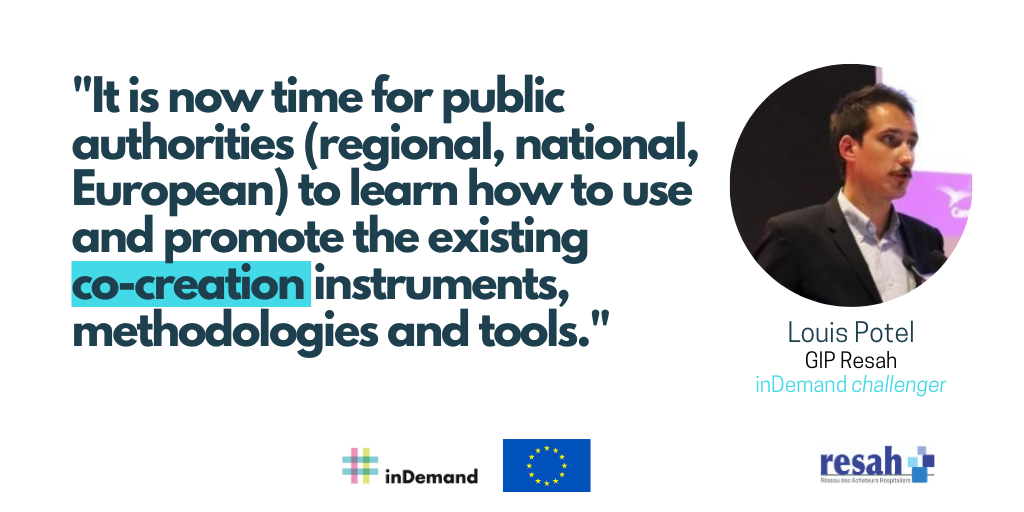5 useful tips to know about demand-driven digital health co-creation

This article was written by Louis Potel, inDemand partner from GIP Resah
The three-years inDemand project has proved* that ecosystem approach can be successfully used for creating new digital health solutions in Europe. Concrete collaboration between healthcare organisations and IT companies, for developing new innovative digital solutions, is a win-win-win process. Companies get privileged access to relevant end-users in order to fully understand their problems and needs. The healthcare personnel actively participates in the systematic co-development of need-based innovative solutions that improve their daily work, patient care processes and services. The regional public development agencies and intermediate organisations generate more impact with the more efficient use of public funding and tailor-made business support to the benefit of the healthcare industry market.
Here are our 5 lessons learnt for a smooth digital health co-creation process for you to take into practice in your next project!
1. Involve healthcare professionals at the right moment in the development process.
Healthcare professionals need to be involved at the very beginning of the co-creation process, for the Challenge definition. This is because the bottom-up approach means healthcare professionals define the needs and/or problems to be solved. However, it is not necessary to involve healthcare professionals at the beginning of the development process of the digital solution (e.g. coding of the IT framework of the solution etc.). Their added value comes at a later stage, to create the medical content of the solution, elaborate the logic between the functionalities or provide user experience feedback for example. This is the reason why in the inDemand co-creation methodology, only TRL 6 to 8 prototypes are eligible.
2. Involve various professional profiles and expertise.
The successful co-creation process requires the involvement of different healthcare professionals (physician, nurses, doctors,…) as well as active involvement of other departments; e.g. Information System department to ensure the compatibility of the final solution with the hospital IT system; Procurement department to anticipate the future procurement of the final solution; Communication department facilitates communication about the co-creation project to all relevant stakeholders.
3. Demand-driven co-creation process ensures shorter development time between the problem definition and the use of the final solution.
Starting the co-creation process based on a TRL 6 to 8 prototype, or an existing IT framework, ensures that the final version can be available after only several months of collaboration. Faster development time is also appreciated by the participating healthcare professionals who are busy with their daily healthcare activities. Agile communication during the whole project life cycle supports obtaining concrete results. It also means that the developers are motivated to work on new innovations also in the future!
4. Raise awareness of healthcare organizations’ staff regarding the benefits of digital health solutions, but also the associated risk.
Health technologies have a promising future in improving the health and overall wellbeing of people. But, with the benefits come new risks to the security of information systems and the privacy of the data they hold and transmit. Involving healthcare organisations’ personnel in the development of those IT solutions gives them a better understanding of the security aspects around the use of digital health solutions.
5. Accelerate the digitalisation of healthcare organisations.
How to do this? The quick adoption and use of innovative digital solutions requires change management skills. The ecosystem approach increases digital health knowledge among regional players. The intensive collaboration will create new, fruitful connections between the different departments of the healthcare organisation. Outcome is that healthcare professionals and the management will better understand each other’s work along the co-creation process. This increased collaborative capacity can also generate future internal collaborative projects or initiatives!
To conclude, “With all the proven benefits that co-creation projects can generate in the development and adoption of innovative digital health solutions, this is now time for public authorities (regional, national, European) to learn how to use and promote the existing co-creation instruments, methodologies and tools. The European digital health innovation ecosystem is waiting for this.” Louis Potel, Head of international affairs & Project manager for demand driven innovation. GIP Resah, France
* Key figures of the inDemand project: 6 Call for Challenges, 148 Challenges received from healthcare organisations’ staff, 24 Challenges selected, 6 calls for solvers, 110 prototype proposals received from IT companies, 22 different co-creation projects for 22 co-created innovative solutions in 3 European regions (Oulu, Murcia and Paris). If you are looking for validated information about the benefit of co-creation project, read “Success Factors of Demand-Driven Open Innovation as a Policy Instrument in the Case of the Healthcare Industry” by the University of Oulu.
***
WANT TO KEEP UPDATED? →REGISTER NOW & RECEIVE OUR NEWSLETTER ← (Promise, we don’t spam!)